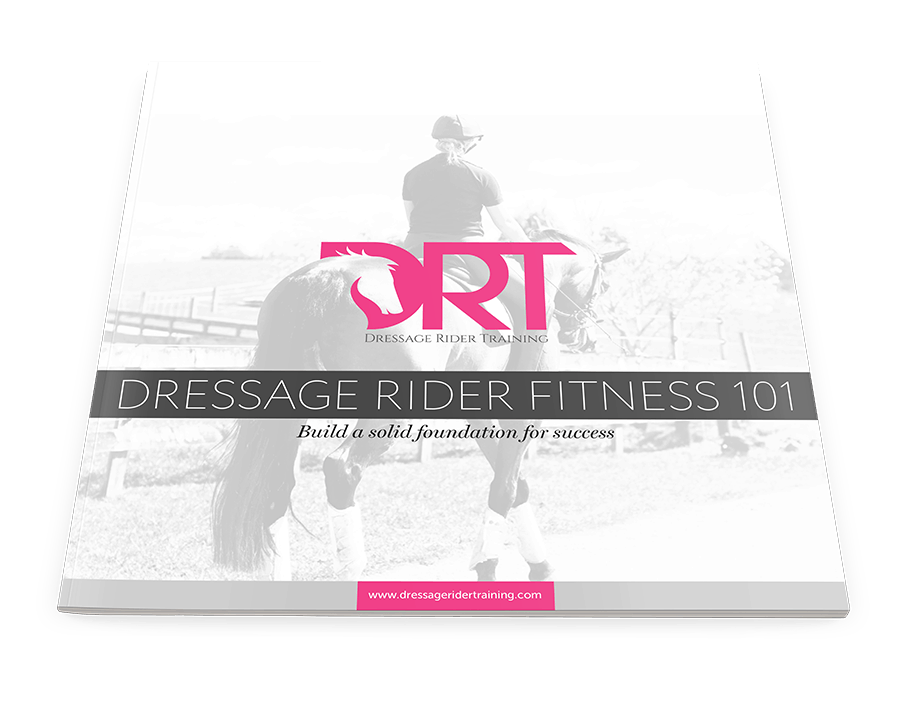Your Hamstrings And How They Affect Your Position In the Saddle
Learn the role your hamstrings play in the saddle and how they impact your dressage seat
Touched your toes recently? Does it feel impossible?
Our hip flexors are often discussed when it comes to riding, and most riders know that they need to address their hips to create suppleness. But what does that mean?
Well, the truth is that when you stretch your hips, you aren’t looking for just one stretch that will undo all that tightness.
There are 21 different muscles involved in your hip movement, and opening them up and creating freedom in the saddle requires addressing them all and creating balance through them.
So, let’s talk about our hamstrings.
The hamstrings are muscles that extend the hip and flex the knee.
In the saddle, the hamstrings will affect your thigh and seat bone positions. If you tend to sit back into a chair position in the saddle, chances are those hamstrings and your deep six are tight as a result of this.
Or maybe the cause.
You may never know who started the issues, but chances are they are both tight.
The hamstrings play an important role when we walk through kinetic energy absorption.
They help protect the knee and hip joints. They also do this in the saddle.
Tight hamstrings impact posture, walking, and riding, contributing to lower back problems.
They directly affect how your pelvis is positioned, in and out of the saddle and how well you move with the horse.
If ignored, progressive tightening of these tissues happens over time. Especially if you have spent time at a desk over the past decade or two.
And if you are nodding your head right now, the truth is it’s the norm for dressage riders to have tight hamstrings. But it doesn’t have to be.
Hamstrings Anatomy
The hamstrings are a group of three muscles:
- Semitendinosus
- Semimembranosus
- Biceps femoris
They are biarticular muscles, meaning they cross two joints (hip and knee), so they play an important role in how you sit in the saddle, how well your pelvis is balanced, and how your thighs can drape down over your horse.
When your hamstrings become tight, they reduce flexibility and range of motion, which affects how your thigh bone positions itself with your pelvis. This has a flow-on effect on how your pelvis sits in the saddle.
It can also be common to have one side tighter than the other, which affects your balance and symmetry in the saddle, not to mention your feel.

How much flexibility do I need?
Well, this all depends on your relationship with your horse, your body shape, your horse’s body shape, and your goals. I will not say you need to be able to touch your forehead to your shins or do the splits.
Everyone is unique, and it’s all about your specific goals.
However, the ability to touch your toes without screwing up your face and using profanity would be a test and good place to start.
Plenty of top elite riders struggle with this, so I won’t say your ability to touch your toes will make you a better rider. However, it will make riding easier and prevent wear and tear, increasing your saddle longevity.
Having the ability to access and control your range of motion supports your riding and your overall general well-being. Plus, you can improve your seat and overall position in the saddle, which ultimately helps your riding.
I believe one of the most important elements is symmetry, not the extreme version of stretches.
Both sides feel even and symmetrical because the truth is we are all crocked to some degree, just as horses are. No one is perfectly balanced, and no horse is born perfectly even.
So, to develop a soft seat that can feel what the horse is doing and where it needs work, we need to know our tendencies inside and out.
That way, we can develop our seat and feel comfortable in the saddle.
Here is a great video from kenhub explaining more about your hamstrings.
Stretches to help your hamstrings
Your nervous system and the length of your tissues affect your hamstring’s range of motion. Consistent stretching and attention are needed to help train both these areas.
Try some stretches out to get you started on improving your hamstring length.
Seated hamstring stretch
Sitting on the ground with your legs together and straight out before you. Let your upper body come forward to feel a stretch in your hamstrings.
You can sit on a couple of cushions to help lift the seat bones and modify the stretch if necessary.
Don’t pull yourself forward and strain your back; instead, think of the distance lengthening in your hamstrings, from the back of your knee to your seat bones.
If you need extra support, use a towel or band. Aim to hold the stretch for 2 minutes.
But begin at around 30 seconds and build your time as your body allows.

Single-leg hamstring stretch
Sitting on the ground, bend one leg in and let the other lengthen out to the side. Similar to before, don’t pull yourself forward and strain your back.
Instead, think of the distance lengthening in your hamstrings, from the back of your knee to your seat bones.
Let your upper body relax, and use a towel or band if you need extra support.
Aim to hold the stretch for 2 minutes. But begin at around 30 seconds and build your time as your body allows.

Supine single-leg hamstring stretch
Lay on your back, reach up to hold your hamstrings or calves, or wrap a towel around your foot.
Then, relax into this position and slowly think about straightening your lifted leg to feel a stretch in your hamstring.
Aim to hold the stretch for 2 minutes. But begin at around 30 seconds and build your time as your body allows.

Aim to do these stretches daily; over time, your hamstrings will lengthen and create more freedom through your pelvis.
Which ultimately creates more freedom and suppleness in the saddle, which helps you develop a softer kinder seat.
Which is what we are all striving for.
If you want more help with hip suppleness, we have created a 21-day program for riders.
Here is a snippet from the program. You can find all the information about it here.
Dressage Rider Training System
Dressage is all about you, the rider and the horse. It is a team sport, so we developed a training system for you as a rider.
It is designed to help you work on symmetry, balance, coordination and suppleness while OFF the horse.
The aim is that when you are riding, you can sit in good posture and control and focus on your horse.
To get started on your journey, download our FREE Rider Fitness guide and discover our training system.
Learn the four elements that go into you as a dressage rider and how you can begin to develop them today.
Want more FREE articles to help you with your dressage rider training? Try these out.
Learn about your deep six and why they matter for dressage
Understanding your pelvis and how it relates to riding balanced and soft
The Corset Of Your Abdominals : Your TVA
8 Key Muscles Involved When We Ride
The Underestimated Power Of Strength Training For Riders
All anatomy images used under license from Kenhub GmbH. Illustrator: Nicola Smith.
More articles
Dressage Rider Training Program
Join other participants on our 12-week 'step-by-step' online rider
training program. Improve the 5 components of your riding.
Only available 3x per year.
see full details & register your interest







